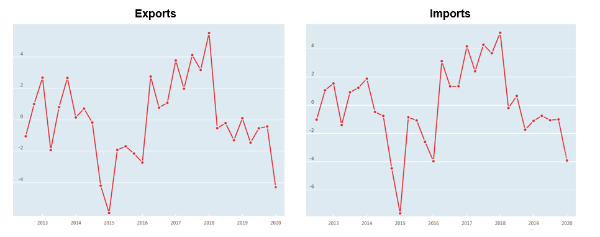Covid-19 Hits G20 International Merchandise Trade In First Quarter

Covid-19 containment measures introduced in many countries in March 2020 hit G20 merchandise trade hard in the first quarter of 2020. Compared with the fourth quarter of 2019, exports fell by 4.3% and imports by 3.9%, and now stand at their lowest levels since the second quarter of 2017. Early indications for April point to more precipitous falls in the second quarter, with Korean and Japanese exports, for example, falling 21.5% and 10.6%, respectively, compared with March 2020.
The impact on international trade across G20 economies varied widely in the first quarter of 2020 due to differences in the rate of the spread of Covid-19, in containment strategies, and in the extent of their exposure to other countries affected by the lockdowns.
France, India, Italy and the United Kingdom, which all introduced nationwide lockdowns in March, saw their exports fall by 7.1%, 9.2%, 4.9% and 7.8% respectively while imports fell by 7.0%, 2.3%, 5.6% and 6.5% respectively. German trade fared slightly better than in other G20 European Union economies, with exports and imports falling by only 3.5% and 2.4% respectively.
In China, exports dropped by 9.3% and imports by 7.0% in the first quarter of 2020, while in Japan exports fell 4.0% and imports were down 4.4%. Trade held up reasonably well in Korea (exports rose by 3.3% while imports contracted 1.2%), although with considerable volatility during the quarter reflecting disruption to Asian supply chains following the initial outbreak of the epidemic in China.
Australia’s exports fell by 3.7%, reflecting reduced demand from Asian partners. At the same time, Russian and Saudi Arabian exports fell, by 9.9% and 10.2% respectively, following the collapse in oil prices.
In Canada and the United States exports fell by 4.2% and 1.9% respectively, but Mexico’s exports saw a slight increase (1.0%). Brazil, which was initially less exposed in the first quarter of 2020 to the Covid-19 outbreak than most other G20 economies, bucked the general trend with exports and imports marginally up (by 0.9% and 2.8%).


 CNS: Will All Children Be Born Free Of HIV, Syphilis And Hepatitis-B By 2030?
CNS: Will All Children Be Born Free Of HIV, Syphilis And Hepatitis-B By 2030? Save The Children: Sudan - One Child Every 10 Seconds Forced To Flee Their Home Since Conflict Began Two Years Ago
Save The Children: Sudan - One Child Every 10 Seconds Forced To Flee Their Home Since Conflict Began Two Years Ago People with Disability Australia - PWDA: People With Disability Invisible In Election Debates And Housing Promises
People with Disability Australia - PWDA: People With Disability Invisible In Election Debates And Housing Promises East West Center: NZ Deputy Prime Minister Recounts Longstanding US-NZ Relationship In The Pacific
East West Center: NZ Deputy Prime Minister Recounts Longstanding US-NZ Relationship In The Pacific Global Jews for Palestine: Jewish Organisations' Passover Statement, After 40 Days Of Starvation
Global Jews for Palestine: Jewish Organisations' Passover Statement, After 40 Days Of Starvation APEC: Stronger Immunization Policies Needed As Vaccine Confidence Falls
APEC: Stronger Immunization Policies Needed As Vaccine Confidence Falls